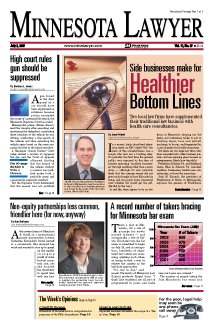Governor Tim Pawlenty will no doubt soon be turning his attention to filling that vacancy on the Minnesota Supreme Court created by Justice Sam Hanson's decision to step down at the end of the year and return to his old firm, Briggs & Morgan. (See story in last week's Minnesota Lawyer, password required.)
The governor -- and whatever committee he chooses to assist him -- will be looking at a variety of factors in choosing a replacement for Hanson. It should obviously be someone who is highly intelligent with a stellar resume and a personalty that will fit well with the rest of the court. No doubt, Pawlenty also wants someone who will not be an activist judge -- whatever that means these days. But what else?
Diversity is probably the biggest other factor that is on the mind of the legal community. With Hanson's departure, the court will be left with one African American justice (who gained his seat through election rather than appointment), two women justices and three justices with the surname of Anderson. There has never been an African American, Native American, Hispanic or Asian candidate appointed to the Minnesota high court -- an odd situation given that there are so many qualified lawyers in each of these groups.
I have no idea who will apply -- or who whatever committee the governor appoints will ultimately recommend -- but I can think of plenty of potential candidates who, not only would add a diverse perspective to the court, but also who are extremely well-qualified. Just to name a few, what about smart-as-a-whip Court of Appeals Judge Mimi Wright or the highly capable and service-minded Hennepin County District Court Judge Tony Leung? What about Bowman and Brooke attorney George Soule, who has done yeoman's work on judicial selection and as an officer at the Minnesota American Indian Bar Association? What about Hennepin County Public Defender Lenny Castro, who was recently a finalist for a seat on the Court of Appeals? And I could go on and on.
The other element to diversity is, of course, the gender composition. Minnesota not long ago was the first in the nation state high court to achieve a majority of women (4/7) -- now we are down to two. There are more well-qualified women candidates in Minnesota than I could ever hope to list here. How about selecting one of them?
I do not think that diversity should be the sole, or even dominant, consideration -- that should be the candidate's qualifications and abilities. However, there are many highly qualified diverse candidates in Minnesota, and a diverse perspective can add much to the court. I hope the governor, who has generally made excellent judicial selections so far, will give give this serious consideration as he mulls whom to put on the high court.
Subscribe to:
Post Comments (Atom)

No comments:
Post a Comment